The Goods and Services Tax (GST) is a fundamental aspect of modern business, streamlining taxation and fostering economic growth. If you're a business owner, obtaining a GST registration is a crucial step to ensure compliance with tax regulations. In this blog, we'll guide you through a step-by-step process on how to get GST for your company, demystifying the complexities associated with this essential requirement.
1. Understanding GST Basics:
Before diving into the application process, it's essential to have a solid understanding of what GST is and how it applies to your business. GST is a value-added tax levied on the supply of goods and services. Familiarize yourself with the different GST rates and categories.
2. Determine Eligibility:
Not all businesses are required to register for GST. Check the eligibility criteria in your country, which often includes factors such as annual turnover, type of business, and interstate transactions.
3. Gather Necessary Information:
Collect all the relevant information and documentation required for the application process. This may include your business registration details, proof of address, PAN card, and bank account information.
4. Online Application:
Many countries provide an online portal for GST registration. Visit the official website of the tax authorities in your region and navigate to the GST registration section.
5. Fill out the Application Form:
Complete the GST registration application form with accurate and up-to-date information. Be prepared to provide details about your business activities, turnover, and other relevant information.
6. Attach Required Documents:
Upload or submit the necessary documents along with your application. Common documents include business registration certificates, proof of identity and address, and bank account details.
7. Verification Process:
The tax authorities will review your application, and in some cases, they may conduct verification checks. Ensure that all the information provided is accurate to expedite the verification process.
8. Receive GSTIN:
Upon successful verification, you will be issued a Goods and Services Tax Identification Number (GSTIN). This unique number is crucial for all GST-related transactions.
9. Configure Accounting Systems:
Update your accounting systems and invoicing processes to incorporate the new GSTIN. Ensure that your invoices comply with GST regulations.
10. Filing GST Returns:
Familiarize yourself with the frequency and process of filing GST returns. Most countries have monthly or quarterly filing requirements.
11. Compliance with GST Regulations:
Regularly check for updates in GST regulations to ensure ongoing compliance. This includes changes in tax rates, filing procedures, and any amendments to the GST law.
Obtaining GST for your company may seem like a daunting process, but with careful planning and adherence to the steps outlined above, it becomes a manageable task. By staying informed and maintaining compliance, your business can seamlessly integrate GST into its operations, contributing to a more efficient and transparent financial ecosystem. If in doubt, seek guidance from tax professionals or consult the official guidelines provided by the tax authorities in your specific country. Happy GST registration!

 SkillClick
SkillClick
